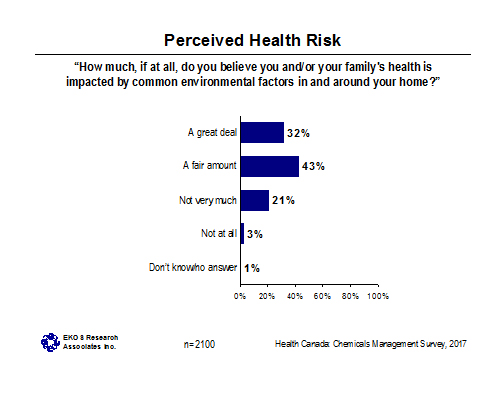
Submitted to:
Health Canada
por-rop@hc-sc.gc.ca
EKOS RESEARCH ASSOCIATES INC.
March 2017
EKOS RESEARCH ASSOCIATES
Ottawa Office
359 Kent Street, Suite 300
Ottawa, Ontario
K2P 0R6
Tel: (613) 235 7215
Fax: (613) 235 8498
E-mail: pobox@ekos.com
EKOS Research Associates conducted a national survey of 2,100 residents of Canada aged 18 and older. The survey was conducted online among members of EKOS’ Probit panel, a randomly selected panel of Canadian households in January 2017. The sample included an oversample of parents with children six years of age or younger (n=573). Weighting was applied to the sample to ensure that the total sample of n=2,100 reflects the characteristics of the general public by region, age, gender and parental status. The total sample of n=2,100 carries a margin of error of +/-2.1 percentage points, calculated at a 95 per cent confidence interval. The targeted sample of parents with children six years of age and younger carries a margin of error of 4.1 percentage points at a 95 per cent confidence interval.
In the second component, ten focus groups were held with a subset of respondents from the survey to further discuss and contextualize findings. Two groups were held in English in Halifax and three were held in each of Toronto and Calgary, in addition to two individual in-person interviews in Calgary. Two groups were also held in French in Montreal.
The total contract value for the POR project is $95,730 (including HST).
Supplier Name: EKOS Research Associates
PWGSC Contract #HT372-163682/001/CY
Contract Award Date: October 20, 2016
To obtain more information on this study, please e-mail por-rop@hc-sc.gc.ca
This certification is to be submitted with the final report submitted to the Project Authority.
I hereby certify as Senior Officer of EKOS RESEARCH ASSOCIATES INC. that the deliverables fully comply with the Government of Canada political neutrality requirements outlined in the Communications Policy of the Government of Canada and Procedures for Planning and Contracting Public Opinion Research. Specifically, the deliverables do not include information on electoral voting intentions, political party preferences, standings with the electorate or ratings of the performance of a political party or its leader.
Signed:
Susan Galley, Senior Vice President
EKOS Research Associates Inc.
The Chemicals Management Plan (CMP) was created to address a need to reduce risks Canadians may face as a result of harmful chemicals in their homes and environment. It is the combined effort of Health Canada and Environment and Climate Change Canada. The plan expands on previous initiatives by assessing the potential risk of chemicals used in Canada and taking action when they are found to be harmful. A key aspect of this is to ensure public awareness of risks and appropriate responses. This is accomplished through making environmental health guides available to Canadians, and through activities such as awareness and learning events, public distribution of information, and social media promotion. The result is a myriad of avenues through which Canadians can be exposed to this vital health messaging; however, a renewed public outreach strategy must be created to provide simple messaging and updated tactics based on Canadians’ information needs.
The current public opinion research explores behavioural and information seeking trends of Canadians related to chemicals and environmental impact. The information will be used by Health Canada in the development of a unified five-year public outreach strategy aimed at prompting Canadians to avoid or minimize risk from harmful household materials. Paramount to this new strategy is an informative social marketing campaign informing and motivating Canadians to protect their health and the health of those close to them by appropriately responding to substances found to be of concern in the home.
The objectives of the research are as follows:
EKOS Research Associates conducted a national survey of 2,100 residents of Canada aged 18 and older. The survey was conducted online among members of EKOS’ Probit panel, a randomly recruited panel of Canadian households. The field dates for this survey were January 11-23, 2017. The average interview length to complete the questionnaire was 18 minutes.
The sample included a targeted segment of parents with children six years of age or younger (n=573). An oversample was collected in this segment to ensure sufficient cases in the analysis of results for this group. Weighting was applied to the sample to ensure that the total sample of n=2,100 reflects the characteristics of the general public by region, age, gender and parental status.
The Probit panel consists of randomly selected Canadians identified via telephone-based RDD dialling (they do not opt themselves into the panel), with a blended landline and cellphone sample frame providing equal probability sampling and full coverage of the Canadian population with access to a telephone. Because of this approach, the samples derived from the Probit panel are considered probabilistic in nature. On this basis, the total sample of n=2,100 carries a margin of error of +/-2.1 percentage points, calculated at a 95 per cent confidence interval. The targeted sample of parents with children six or younger carries a margin of error of 4.1 percentage points at a 95 per cent confidence interval.
The survey instrument was pre-tested with 71 cases (40 in English and 31 in French) to ensure that the data was being accurately recorded and that the questions were properly understood by respondents.
Respondents were invited to complete the survey via a bilingual e-mail invitation message sent to the randomly selected sample frame. The questionnaire was programmed online on a secure webserver accessible only to individuals with a valid PIN. Respondents were offered to complete the survey in the official language of their choice, as well as through an accessible version which can be read using screen reading software.
To reach the full sample of 2,100, a total of 13,105 panel members were randomly selected, using a stratified approach (to reach the target group and ensure sufficient sample in smaller geographic regions with smaller populations). The participation rate for the survey was 16 per cent. This is a typical participation rate for this kind of survey.
Total |
|
|---|---|
n= |
2100 |
What is the language you speak most often at home? |
|
English |
78% |
French |
23% |
What is the highest level of formal education that you have completed? |
|
High School or less |
24% |
Registered Apprenticeship or other trades certificate or diploma |
6% |
College, CEGEP or other non-university certificate or diploma |
22% |
University certificate or diploma below bachelor's level |
9% |
Bachelor's degree |
29% |
Post graduate degree above bachelor's level |
18% |
Which of the following categories best describes your total household income? That is, the total income of all persons in your household combined, before taxes? |
|
Under $40,000 |
20% |
$40,000 to just under $60,000 |
14% |
$60,000 to just under $80,000 |
12% |
$80,000 to just under $100,000 |
12% |
$100,000 to just under $150,000 |
19% |
$150,000 and above |
12% |
Refused |
11% |
Were you born in Canada? |
|
Yes |
86% |
No |
14% |
Do you own or rent your home? |
|
Own |
72% |
Rent |
26% |
Are you the parent or legal guardian of any children currently living in the household? |
|
Yes |
42% |
No |
57% |
What are the ages of children in the home? |
|
Under 6 |
65% |
6-12 |
37% |
13-15 |
14% |
16-18 |
12% |
19 or older |
14% |
Are there individuals living in your home who are 65 years of age or older? |
|
Yes |
24% |
No |
76% |
Are there individuals living in your home who are vulnerable to health risks?(e.g., children and pregnant women, Indigenous peoples, seniors)? |
|
Yes |
24% |
No |
73% |
Region (unweighted) |
|
British Columbia and Yukon |
14% |
Alberta and Northwest Territories |
9% |
Saskatchewan and Manitoba |
10% |
Ontario |
35% |
Quebec and Nunavut |
21% |
Atlantic |
11% |
Age (unweighted) |
|
18-34 |
24% |
35-44 |
21% |
45-54 |
18% |
55-64 |
16% |
65+ |
18% |
Gender (unweighted) |
|
Male |
48% |
Female |
52% |
In terms of possible response bias, the sample over represents those with post secondary education, including 56 per cent with a university level of education compared with 23 per cent in the population, and under represents those with high school/elementary or college levels of education. There are fewer Canadians born outside of Canada represented in the sample (14 per cent) than found in the population (25 per cent).
Overall results are presented in text, charts, and tables. Bulleted text is used to describe specific segments of the sample if they are statistically and substantively different from the overall results for the entire sample (i.e., at least five per cent or more from the overall mean in any given subgroup). If differences are not noted in the report it can be assumed that they are either not statistically significant in their variation from the overall result or that the difference was judged to be too small to be noteworthy.
Readers should note that results for the proportion of respondents in the sample that either said “don’t know” or did not provide a response may not be indicated in the graphic representation of the results. Results may also not total to 100 per cent due to rounding.
In order to add further context and understanding to the survey results, nine focus groups were held in four Canadian cities (Montreal (2), Toronto (3), Halifax (2), and Calgary (3), as well as two key informant interviews held in Calgary. Participants were recruited from the EKOS in-house randomly generated panel, Probit (recruitment screener can be found in Appendix C). Half of the discussions targeted recruitment on parents of young children (6 years old or younger), while the other included parents of older children and other Canadians. Groups were stratified to ensure a balance of men and women and representation of a variety of adult age cohorts. In total, 63 individuals participated in the discussions, of the 85 recruited. A focus group guide (provided in Appendix D) was developed by EKOS in consultation with the client. Discussions centred on a number of issues common to the survey: concerns about health risks in and around the home, steps taken to reduce risk, sources of information and assessment of quality and trustworthiness of information available, as well as views about how well informed participants feel and corresponding information needs. Participants were also asked to provide feedback on three concepts under consideration in the development of a public education campaign. Most discussions were held in English, with the exception of the two focus groups held in Montreal, which were held in French.
Each focus group was 90 minutes in duration. Groups were held in professional focus group facilities. Refreshments were provided and participants were provided $75 for their attendance. Video or audio recordings, researchers’ notes and observations from the focus groups formed the basis for analysis and reporting of results.
It should be kept in mind when reading this report that findings from the focus groups are qualitative in nature, designed to provide a richer context rather than to measure percentages of the target population. These results are not intended to be used to estimate the numeric proportion or number of individuals in the population who hold a particular opinion as they are not statistically projectable.
Most Canadians feel that common environmental factors in and around their home have an impact on their own or their family’s health. About one-third (32 per cent) said they believe there is a great deal of impact, while another two in five (43 per cent) say they are impacted a fair amount. Conversely, one in five (21 per cent) do not perceive that environmental factors in the home have very much of an impact, and a few (three per cent) feel that the impact is non-existent.

When focus group participants were asked about how or when they started thinking about the health risks of things in and around their home many said that there is no “starting point” that they can point to in terms of awareness of these issues. They described the gradual and evolving process of becoming more aware of the impact of environment on health as society is paying more attention about these two issues over time. “Awareness is building in layers for all of us”. Many said that as society is slowly becoming more aware, it is becoming more commonplace to be concerned about health risks. Some also said that they have always been conscious of these issues, largely from their upbringing at home (from parents who were more conscious and concerned about impact on health and healthy lifestyle choices).
For others, having children had a large impact on the attention that they pay to these issues. “You start hearing about things like whether or not to vaccinate”, and health risks and concerns start to take on new meaning and importance.
Similarly, some described getting older and feeling more vulnerable because of health concerns as the impetus to start thinking about these issues. Related to this, people in the home with allergies or environmental sensitivities have some households paying more attention and taking greater care with choices of products, what comes into the home, and how cleaning and renovations are performed.
Many said that you simply “hear things”. There are conversations that happen with people you know (e.g., other parents, colleagues) that start you thinking. News and other content in the media (e.g., talk shows, consumer report shows) increase your attention, not just to the immediate topic, but to other similar health issues. Kids also come home with information, according to some parents, that also starts conversations and gets you thinking.
Selected from a list provided, two-thirds of Canadians feel that household chemicals (66 per cent) and pesticides (64 per cent) pose a risk to their health or family’s health. This seems a marginal increase from 2016 when 61 per cent felt the same1. Half (51 per cent) feel that substances such as oil, turpentine, paint, and paint thinners pose a risk. Roughly two in five think that air fresheners and scented candles (43 per cent), building materials and renovation supplies (43 per cent), the lead in applied paint (42 per cent), or improper disposal of pharmaceutical drugs (40 per cent) are a risk to their health. About one-third perceive a risk in personal care products (36 per cent) or unused pharmaceutical drugs (36 per cent). One-quarter are concerned about consumer product safety (25 per cent), while one in five feel that materials used for hobbies or crafts (18 per cent) are a risk to their health. Only one in ten (11 per cent) feel that natural health products are among the factors in their home that pose a risk to their health.
Perceived Risk of Household Products
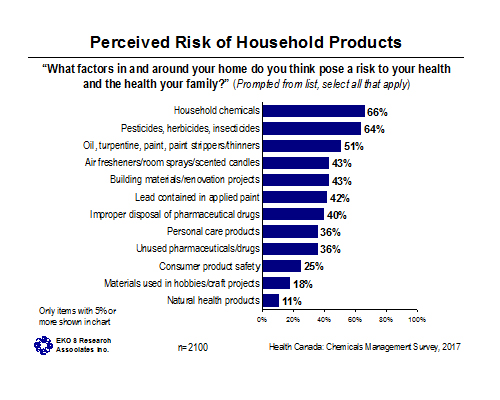
1. Canadian Environmental Health Habits and Behaviours Survey, TNS Canada, 2016.
Turning to the risks presented by household environmental factors, two-thirds of Canadians feel that air quality (66 per cent) or mould and humidity (60 per cent) pose a risk to their health or family’s health (again based on a list provided). Over one-half feel that water quality (55 per cent) poses a risk. Roughly two in five think that carbon monoxide (44 per cent), food safety (41 per cent), or cigarette smoke (41 per cent) are a risk to their health. About one-third perceive a risk in contaminated soil (32 per cent), wireless devices (32 per cent), radiation (31 per cent), or garbage and disposal of products (31 per cent). One-quarter are concerned about radon gas (28 per cent) or excessive noise (26 per cent). Finally, one in five (18 per cent) include wood smoke among the factors in their home that pose a risk to their health.
Perceived Risk of Household Environmental Factors
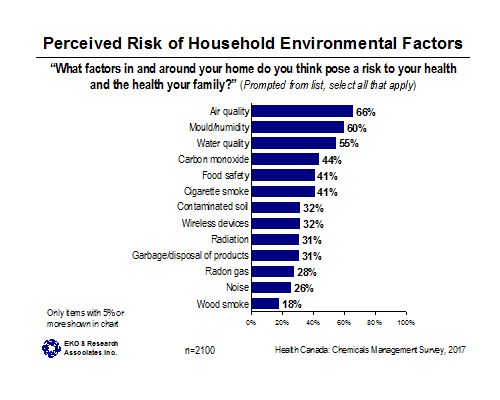
When asked to select the single greatest factor of concern, the same top five factors noted previously as posing a risk to their health or family’s health were reported from the list provided to respondents. One-third of Canadians (34 per cent) say they are most concerned about air quality, while nearly as many are concerned about water quality (29 per cent). About one-quarter are concerned about mould and humidity (26 per cent) or pesticides (25 per cent). One in five are most concerned about household chemicals (19 per cent). One in ten are concerned about food safety (such as safe handling practices and preparation) (11 per cent), carbon monoxide (10 per cent), or cigarette smoke (10 per cent). A variety of other concerns are also mentioned, including wireless devices (seven per cent), personal care products (seven per cent), or building materials (six per cent). Fewer (five per cent each) are most concerned about consumer product safety, air fresheners, paint-based products, improper disposal of pharmaceutical drugs, radiation, or lead in applied paint.
Factors of Greatest Concern
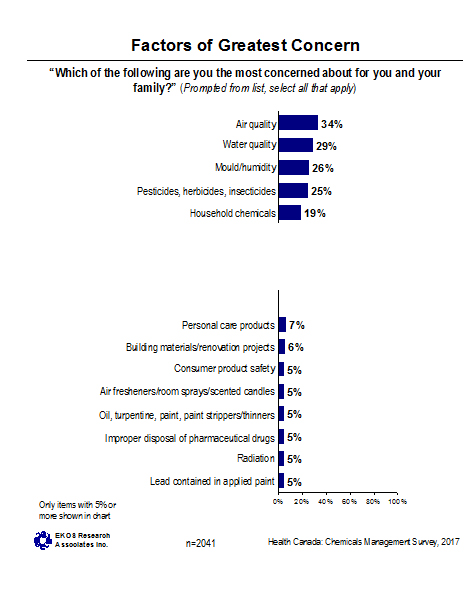
Focus participants expressed concern about a number of environmental factors and household products in and around the home. These perceived health risks include products such as household cleaners, along with specific agents for a few such as Bleach, Borax, and “dollar store” cleaners. Some participants are concerned about various plastics in the home (food containers, water pipes) and use and storage of pesticides. Focus group participants living in older homes are concerned about factors “unknown” in the home such as the use of asbestos or lead paint in the home prior to their occupancy. Some are concerned about environmental factors including mould in the home from windows or other leaks, along with carbon monoxide, and particles released from carpets. A few are concerned about products and air quality because of the prevalence of asthma or eczema for members of their household.
Participants in Halifax are primarily concerned about Radon; however, participants overall are most concerned about the factors that are unknown or they feel they have less control over (asbestos, mould, “what is under the layers of paint”, things neighbours are burning).
Canadians are concerned about dozens of hazardous chemicals that may pose a risk to their own or their family’s health. Over half of Canadians feel that three chemicals pose a risk from the list provided; lead (55 per cent), asbestos (53 per cent), and mercury (50 per cent). Two in five indicated that arsenic (43 per cent), bisphenol A/BPA (42 per cent), formaldehyde (39 per cent), or Dioxin/PCB’s (38 per cent) pose a risk. One-quarter are concerned about the risk of microbeads (28 per cent), flame retardants (26 per cent), dyes and pigments (24 per cent) and phthalates (23 per cent). Ethylbenzene (22 per cent) and Triclosan/anti-microbials (21 per cent) are perceived as a risk by one in five. About one in seven feel that nanomaterials (15 per cent) or Boric Acid (13 per cent) pose a risk to their health. Only one in ten are not concerned about anything specific (11 per cent) or do not know (11 per cent).
Types of Chemicals/Products Posing Risk

The majority of Canadians are concerned that exposure to chemical substances in their home can potentially lead to breathing problems (60 per cent) or cancer (58 per cent) compared with other health impacts from the list provided. This is a similar level of concern shown in 20092 when respiratory problems and cancer also topped the list. Two in five (40 per cent) are concerned that chemical exposure will result in allergies. One-third believes that exposure to chemical substances may impact children’s health or development (34 per cent), result in neurological problems (33 per cent), poisoning (32 per cent), or chemical sensitivities (32 per cent). One-quarter are concerned that exposure will result in digestive problems or stomach disease (27 per cent), and one in five are concerned about reproductive or fertility effects (18 per cent).
Nature of Risks Posed
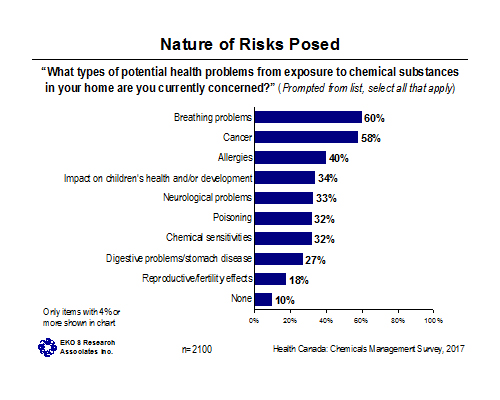
2. Management and Environmental Health Issues: Baseline Survey, Environics Research Group, June 2009.
Most Canadians (84 per cent) agree that it is possible to take steps to prevent or lower health risks posed by common household products. Nearly three-quarters of Canadians agree that how consumers use (73 per cent) or dispose of (72 per cent) common household products is a large part of the risk posed to health. Two-thirds agree it is possible to test for some chemicals in the home that pose a health risk. About half (52 per cent), however, feel that chemicals in common household products pose a significant health risk no matter how they are used or disposed of by consumers.
Perceptions on Mitigating Risk
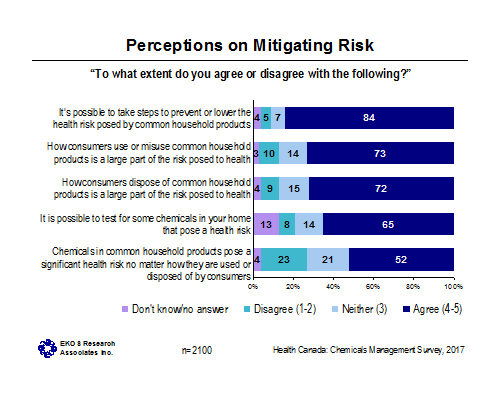
Most focus group participants feel that it is possible to take steps to prevent or lower the health risk of environmental factors and household products. These participants said that it is worth taking action to prevent risk and make a conscious choice to do, or not do, certain things that are within their control. As explained by one participant, “I think you always have a choice, and sometimes your choice is just not to use them”. For some, the actions are so routine that they did not come to mind immediately. Many of the steps taken include obtaining information, such as researching products online and reading product labels and MSD sheets. As noted by one “knowledge is power”.
Most Canadians would like to take informed action about health risks. Over three-quarters (78 per cent) said it is likely that if they had information about possible health risks around their home, along with steps to take, they would make changes to reduce the risk. Of the one in five (18 per cent) who said they would not, the primary reasons are that the steps would likely be too expensive (17 per cent), they do not feel it is a big enough problem (13 per cent), that the information is often contradictory or confusing (11 per cent), or that they rent their house and can not control the changes (10 per cent).
Likelihood of Taking Action
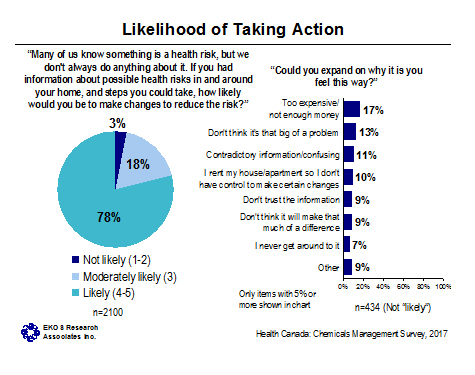
Most Canadians are either confident (40 per cent) or moderately confident (41 per cent) that they know what steps to take to prevent or reduce the health risk to their family from environmental factors in and around their home. Fewer than two in five (17 per cent) say they are not confident.
Confidence in Knowledge to Take Action
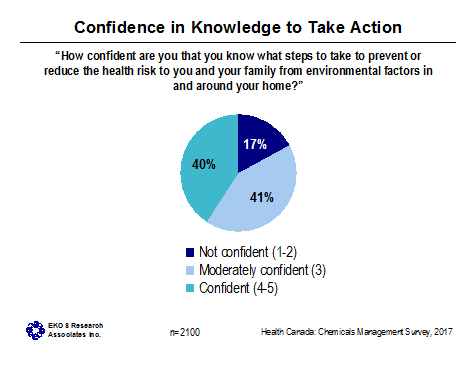
Many focus group participants said they feel well enough informed of the risks associated with environmental factors and household products. Some said it is their own responsibility to inform themselves; however, some contend that they are limited by not having enough available time to research information or source “safer” products, along with feeling confused by conflicting or new information, particularly for those with children. For example, one described using Borax to clean diapers for a first child but was advised not to use for second child; another said, “We had to get all non BPA stuff for the 6 year old but, hey we already gave this stuff to the 11 year old and she seems okay”. A few noted the small print on the labels of cleaners and other products as a barrier to understanding the contents and risks.
Some do not feel well enough informed; primarily those who feel that there are factors which pose a risk no matter what they do. These participants are also most concerned about factors in the environment (such as cellular towers, noise levels from traffic or construction) or the effectives of cumulative exposure (“what about when chemicals are mixed – you use one cleaner, then you use another cleaner – what are the effects. No one knows” or “Why are kids getting more allergies now?”). In addition, a few mentioned that “natural” products cost more, but may not necessarily be safer to use; “(natural products promote that) they are environmentally friendly but they really aren’t”.
Canadians have taken a multitude of actions with the aim of protecting the health of their family from environmental contaminants or factors in and around the home. Three-quarters report that they open windows and ensure proper ventilation (75 per cent) or maintain a smoke free home (73 per cent), according to results from the list provided. Over half said they properly dispose of unused or expired pharmaceuticals (59 per cent), read all instructions on product labels (58 per cent), follow those instructions (57 per cent), use protective equipment (56 per cent), or use products with fewer chemicals (52 per cent). Over one-third make sure to clean and dust frequently (39 per cent), obtain information or conduct research (39 per cent), or remove the source of the problem (38 per cent). Fewer than one in five have spoken with family, friends or neighbours (16 per cent), reduced time spent in the problem locations (15 per cent) or have talked to a health professional (14 per cent). Six per cent have hired a professional to help with renovation issues (such as to remove asbestos or lead paint), and five per cent have tested for radon in their home.
Types of Actions Previously Taken
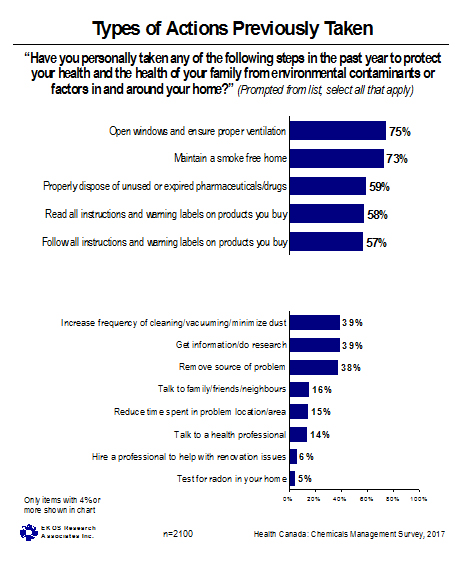
Many cited actions that are preventative or include safety measures for the use of household products. These include storing chemicals (such as household cleaners and outdoor pesticides) in separate cabinets, marked containers, and especially away from children. Proper use of household products was often noted, including wearing gloves or a mask during use, and proper ventilation of the home, especially for tasks such as painting or cleaning the oven. Cleanliness is also a factor including washing hands and food, not wearing shoes indoors (because of contaminants picked up outdoors), and keeping the house clean and free from dust and particles (including regularly changing the furnace filter).
Many also described some choices they make about products they bring into the home. Some mentioned they use household cleaners promoted as environmentally-friendly cleaners, along with using “old fashioned” cleaning methods such as baking soda and vinegar; “use more elbow grease for cleaning and less products”. Some participants said they buy water-based paints or ensure that the plastics they purchase do not contain BPA. A few explained that they avoid the use of carpets in their home to minimize environmental factors trapped in fibres, or purchase carpeting that does not use chemical treatment. Decisions on personal products were also noted such as using soaps or deodorant that are considered to pose less risk. A few take steps specifically regarding lightbulbs; “I had to replace all my led light bulbs, I don’t like when they break because they release chemicals. I was worried for my family.”
Of note, while many participants in Halifax are concerned about radon, very few have taken steps to have their home tested for radon, citing the cost of the test or lack of awareness about how to arrange for testing.
As noted, almost all of those who participated in the survey have taken at least some steps to protect themselves from household contaminants. Of these respondents, one in five (19 per cent) say they took these steps because of information they had come across. One in six, meanwhile, were motivated by concerns for the health and safety of those in the home (16 per cent) or for their own health (14 per cent). One in ten say they felt these measures were simply good practice (11 per cent) or that they took these measures to accommodate personal health issues (such as allergies) among those in the home (11 per cent).
Reasons for Taking Action
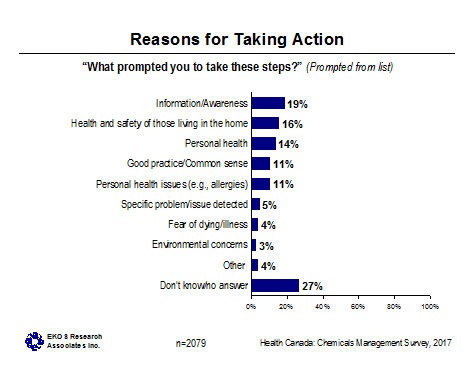
Canadians primarily look to protect their family when taking action to reduce health risks from environmental factors in the home. Over four in five (86 per cent) indicated that their health and the health of their family is the reason they take steps to prevent or reduce risks. Two-thirds (66 per cent) said they take action because it is good for the environment. One-third (35 per cent) have a practical motivation of increasing the value of their home. Roughly one in five are influenced by other people and have taken steps to prevent or reduce health risks because someone prompted them to take action (22 per cent) or because someone else was doing it (19 per cent).
Motivations to Act
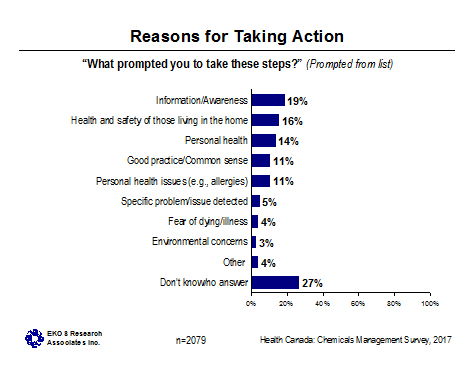
Overwhelmingly, focus group participants talked about health and the health of their family, particularly children, as the reasons for taking steps to reduce risks from environmental factors and household products. As described by one participant, “Health of my children is most important, and your own health comes after that. Once that is addressed, everything else is a dead heat for third place.” Many said that environmental concerns are a benefit to taking action (with some noting the overlap between actions that improve personal health also can help the environment, such as not pouring contaminants down the drain). A few participants also pointed to pressure or influence from family and friends as a reason for taking action. Very few cited the benefit of increasing the value of (or ability to sell) their home as a reason for taking steps to reduce risk.
Although most Canadians feel that common environmental factors in and around their home have an impact on their personal or their family’s health, fewer have looked for information on the steps to take to reduce risks. Just over half (56 per cent) of Canadians say that they have looked for information on what steps can be taken to prevent or reduce risks from environmental contaminants in and around the home. Two in five (41 per cent) have not. Of those who have looked for information, only one in seven (14 per cent) say that the information was not helpful. Most feel that the information found was helpful (44 per cent) or moderately helpful (41 per cent). By comparison to results collected in a similar study and question in 20093, current findings suggest that Canadians are more apt to find information helpful than they were eight years ago, when only one in five found the information helpful.
Looking for Information on Steps to Take
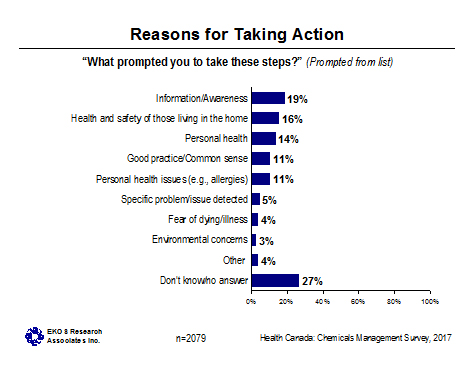
3. Chemical Management and Environmental Health Issues: Baseline Survey, Environics Research Group, June 2009.
As noted, of those who looked for information on what steps can be taken to prevent or reduce risks from environmental contaminants in and around the home over half found the information to be only moderately or less helpful. From the list provided, two in five (43 per cent) of these found the information to be less than optimally helpful because they lacked confidence in the source of information. Slightly fewer feel that the information is not practical (38 per cent), or confusing or too technical (36 per cent). Roughly one-third said that there is not enough information (35 per cent) or that the information is hard to find (34 per cent). Just over one-quarter (28 per cent) said that the information was limited in terms of not communicating the impacts or consequences of exposure. One in five were overwhelmed by the information (22 per cent) or the information was not what they wanted to know (22 per cent).
Limitations of Information
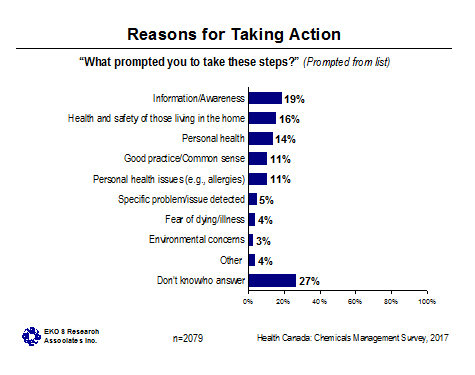
From the perspective of focus group participants the user-friendliness of information currently available is moderate and mixed. Many said that they can find information, but others said that they are not sure where to find good information. Two major complaints about information are that it is not relevant (i.e. not what they need to know) or is very technical in nature and difficult to decipher. Many participants expressed that it is all about the sources of information. If sources are recognizable, reputable and trustworthy, then likely the information is as well. Many of the sources they encounter when looking for information they either do not consider to be reputable or come from organizations that are likely biased (e.g., product manufacturers with something to gain, special interest groups) and can be misleading in subtle ways. Having information that is verified is seen as key for many.
As noted, more than two-fifths of those who looked for information on what steps can be taken to prevent or reduce risks from environmental contaminants found the information helpful. Of these respondents, one-fifth (20 per cent) found information on how to safely dispose of hazardous material to be helpful, selected from the list provided. One in six were aided by information on usage and storage practices (16 per cent) or by information to help assess the level of risk to one’s health (14 per cent). About one in ten made use of information on how to minimize exposure to environmental contaminants (11 per cent), found the information to be clear and practical (eight per cent), found the information on product and company specifics to be helpful (eight per cent), used the information to find less harmful alternatives (seven per cent), or learned more about household ingredients that are harmful (six per cent).
Usefulness of Information

There are many reasons that keep Canadians from getting the information they need or taking steps to prevent or reduce health risks from environmental factors in the home. Among the tested options, two in five (41 per cent) said that it is too expensive to take steps or make changes to reduce risk. About one-third reported a lack of control to be able to make certain changes (34 per cent), that the information is not available when making decisions (33 per cent), or that the information is confusing or complicated (31 per cent). One-quarter said the information is hard to find (26 per cent) or it is too time consuming to make changes (26 per cent).
Reasons for Limitations of Information
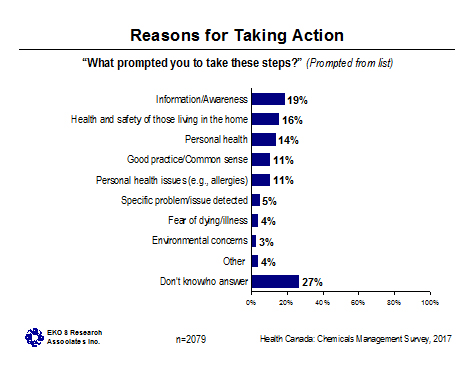
Those respondents who rated two or more of the factors from Section 4.3 as major obstacles to taking action were asked to select what they consider to be the greatest barrier from a list provided. For nearly one-third (31 per cent), the largest single barrier to taking action to reduce the health risk of products in and around the home is that it is too expensive to take action. Fewer than two in five say the information is too confusing (19 per cent), they feel a lack of control to make changes (16 per cent) or the information is not available when making decisions (15 per cent). Seven per cent indicated that information is hard to find or it is too time-consuming to make changes.
Barriers to Taking Action

Many focus group participants said that cost is a barrier to taking action in some cases. As noted by one, “You want to do the best you can, but there are many things that can cost more and you have to balance with other cost issues”. Environmental products tend to have higher prices that add up over time, and renovations that involve remediation to remove asbestos or mould are also a significant cost. A few participants in older homes indicated reluctance to begin a renovation for fear of revealing the unknown contaminants currently “undisturbed” in their home and the associated cost. However, some participants said that many actions require no cost (such as proper use and storage of household products) or may cost less than traditional household products (such as using vinegar to clean rather than single-purpose cleaners).
Some participants, particularly those with higher income, said that cost is not a barrier to them when considering actions that they perceive will protect their health; “we will find the money to do this”.
Other barriers, noted by some, include the time involved to take action to reduce risk (researching information, sourcing ‘better’ products or buying organic at special stores or markets take time or are less convenient). A few participants rent their house or apartment; with a portion indicating that their landlord is attentive to any concerns and another portion with potential risks in their home that are not addressed by the landlord. Finally, a few said that they do not do more to address risks “because of procrastination or inertia. If something came up, (I) would pursue doing more”. For these participants, products that have been stored in their home for years, or a lack of evidence of environmental factors causing risk in their home, are not perceived as a threat and therefore not addressed.
Among those who have looked for information on steps to prevent or reduce risk from environmental contaminants, two in five (40 per cent) indicated they have taken steps to reduce risk as a result of information heard or read. Just under half (48 per cent) have partially taken some steps, and one in ten (10 per cent) have not.
Impact of Information on Taking Action
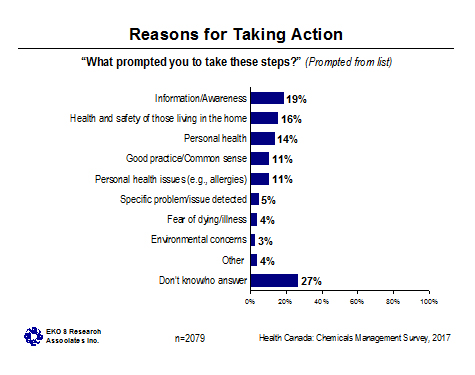
The small number of respondents (n=60) who indicated they had not taken any steps to protect their health from environmental contaminants were asked to identify the actions they would be likely to take in the future from a list provided. Two in five (40 per cent) said they would not take any steps. Of those who would, just over one in ten would open windows and ensure proper ventilation (15 per cent), maintain a smoke free home (13 per cent), or use protective equipment (11 per cent). One in ten said they would follow (10 per cent) or read (nine per cent) all instructions and warning labels on products they buy. Varied other actions would be taken by very small proportions, including increasing the frequency of cleaning (seven per cent), searching for information (six per cent), using products with fewer chemicals (five per cent), reducing the time spent in problem areas (five per cent), or removing the source of the problem (five per cent).
Nature of Impact on Action
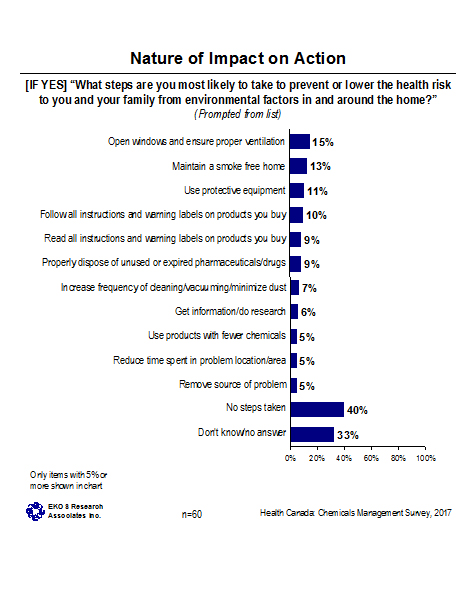
Some people look for information on the risk of environmental health products in their home while others do not. When purchasing a product, fewer than one in five (15 per cent) said they always look for information about what a product contains before purchasing. Nearly two-fifths (37 per cent) indicated they read product information before purchase most of the time. One-third (33 per cent) do this sometimes and fourteen per cent said they almost never read product information. Based on a general comparison of results from a similar question posed in 2009, findings suggest that consumers today are more likely to look for information about products before purchasing them at least some of the time, but not always. In 2009, about three in ten said that they never looked for information, but at the same time one in four said they always do.
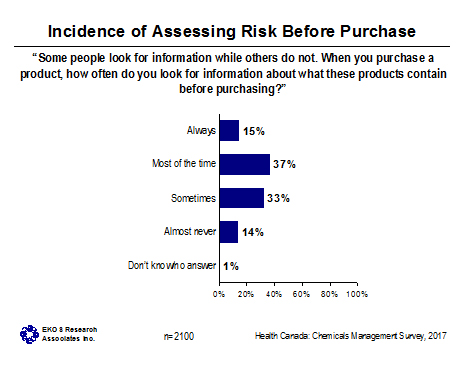
Respondents showed a keen interest in staying informed on how best to protect their health around the home, with two-thirds (66 per cent) indicating they would like to learn more on the subject. One in four (24 per cent) said they are moderately interested and just one in ten (nine per cent) expressed little to no interest. A general comparison with 2009 suggests that the level of interest has risen over the last eight years, given that only a third said they were interested in 2009, and one in five said that they were not interested.
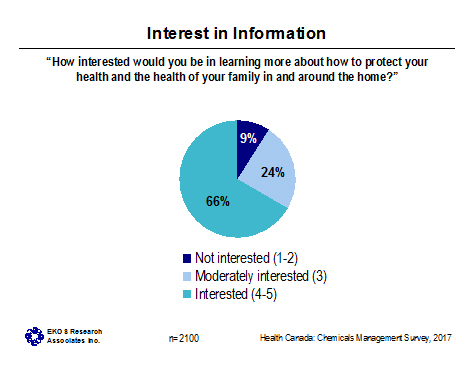
Those respondents who expressed at least some interest in learning about protecting their health around the home were asked to select the various household products about which they would like to receive more information. Two-thirds (65 per cent) indicated that they would like to learn more about household chemicals from the list provided, while half would like to learn about pesticides and herbicides (52 per cent) or personal care products (51 per cent). Two in five would like to hear more about products that emit fragrances (41 per cent) and building materials (38 per cent). Three in ten also expressed interest in consumer product safety (31 per cent), lead contained in paint (29 per cent), various paints and solvents (27 per cent), unused pharmaceuticals (27 per cent), and improper disposal of pharmaceuticals (25 per cent). Respondents are comparatively less interested in natural health products (22 per cent) and materials used in craft projects (18 per cent). Household chemicals were also at the top of an unprompted list in 2009.
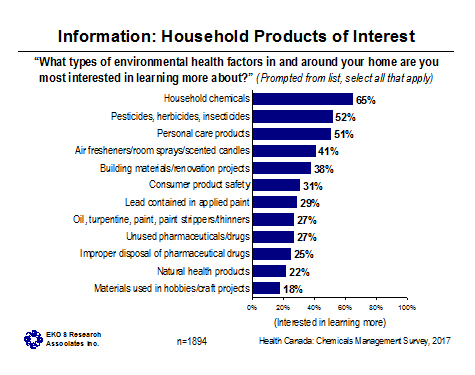
Respondents who conveyed a desire to find out more about protecting their health around the home were also asked to identify the various environmental factors about which they would like to learn more. Air and water quality topped the list, selected by 66 per cent and 60 per cent of respondents, respectively. Half (54 per cent) expressed interest in mould and humidity, while two-fifths would be interested in receiving information on wireless devices (41 per cent). Three in ten selected disposal of products (34 per cent), radon gas (33 per cent), food safety (33 per cent), radiation (32 per cent), carbon monoxide (32 per cent), or contaminated soil (27 per cent). Fewer than one in five respondents showed an interest in noise (17 per cent), wood smoke (15 per cent), or cigarette smoke (14 per cent).
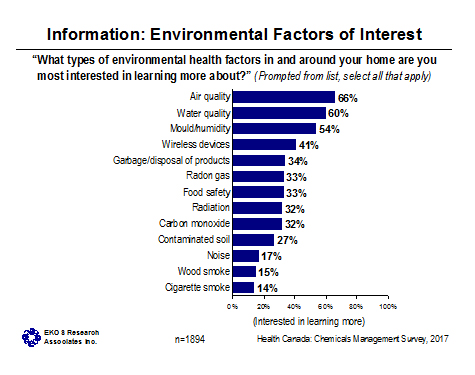
In terms of need for additional information, tools or products focus group participants often found it difficult to pinpoint. They did suggest that there is a clear need for more straightforward, easy to use and relevant information, and that this information needs to be organized and available on a well publicized site so that everyone knows where to access it. Websites that provide references and link to other sites for more detail were also seen as a helpful way to organize information. A few participants talked about a dedicated “product safety” website that provide updates, consumer ratings, and information on what to look for, how to implement solutions, what to do in an emergency and so on.
Some participants emphasized the need for clear product labels that tell you what you need to know (e.g., warning symbols related to health risk), without crowding it with a lot of excess or technical detail. Some spoke about product information and warnings pushed out through key websites, and use of videos with product information and consumer ratings, that many find trustworthy.
In-store product endorsements or endorsements on labels of healthy products were also mentioned as useful. This was discussed, in part, within the context of the growing evolution of consumer awareness and demand for healthier products. Manufacturers’ increasing awareness of this is reflected in the recent Tide advertising campaign to remind parents about safe storage of laundry pods away from children. This was brought up in several of the discussions as a valuable contribution to awareness.
New product lines and warnings and recalls from product manufacturers also have a big impact, according to some participants. Several in Calgary described, for example, a family member or someone in their social circle starting to become connected with or informed about a new natural product line that opened up new awareness and conversations about what to pay attention to and how to do things differently. Similarly, public warnings and recalls are attention grabbers that get many consumers thinking, not just about the specific product, but generally paying more attention to impact of products and product use on health.
Respondents were asked to identify the various sources that they would consult for information on household health risks from a list provided. As in 2009, online search engines rank as the most popular medium for obtaining this information, with three-quarters of respondents (74 per cent) selecting it as a key outlet. Six in ten (60 per cent), meanwhile, indicated that they would consult the Health Canada website, which seems higher than found in 2009 when it was a distant second to online search engines in an unprompted list. Half (48 per cent) would simply check the product label, while four in ten (38 per cent) would seek guidance from a health professional. These two emphasize the importance of clear labelling and assistance of health professionals in educating the public. About one-third would turn to a retailer (35 per cent), news media (33 per cent), a health professional website (30 per cent), print media such as books (30 per cent), or the product manufacturer (29 per cent). Health professionals also seem to have risen as a preferred source compared with results from 2009, although 2009 did not provide a list to respondents so health professionals may simply not have been an obvious, top of mind choice. One-quarter would obtain their information from websites hosted by a federal department other than Health Canada (27 per cent), a provincial government (27 per cent), a consumer group (26 per cent), or an environmental group (24 per cent). One in five would rely on friends (22 per cent) or their municipal government’s website (20 per cent). Information channels that were selected by fewer than one in five respondents include building contractors (16 per cent), home shows (11 per cent), 1-800-O-Canada (11 per cent), and a foreign website (nine per cent).
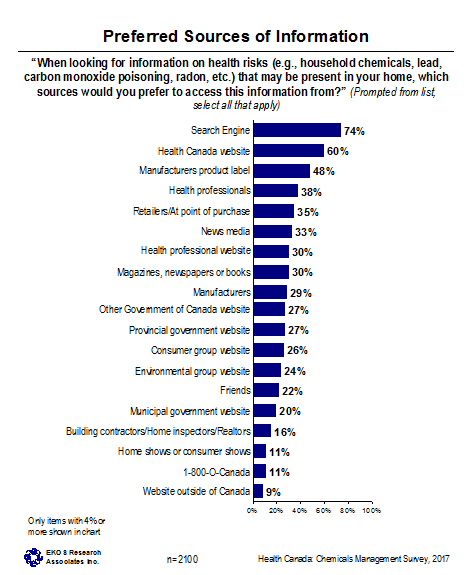
Focus group participants described a wide variety of sources that they like to use. Many talked about online searches using Google or going to key trusted sources like WebMD. Online consumer reports and ratings were noted as a good source (i.e., strength in numbers). Some talked about shows on television and the radio (e.g. Marketplace, Holmes on Homes) that provide information about product safety and risks related to use, storage and disposal. That said, several also said that they would welcome more of this type of specific and practical information on what to and not to do. A few also talked about specific knowledgeable sources (e.g., friends or colleagues in specific occupations, connections with industry associates or informed parent groups). Several participants in different discussions also spoke of reliance on academic studies and information from health professionals (e.g., physical, pharmacy, information put out by hospitals) or large and reputable NGO’s (Canadian Lung Association, Canadian Cancer Society, Heart and Stroke Foundation). Manufacturer product labels and websites are also considered good information sources for some, while others tend to be suspicious of these or find them unhelpful because of lack of clarity.
Generally sources that are trusted and reputable carry considerable weight for many. Use of many sources to corroborate information is also a key approach for some.
Many also noted that information is ever changing and consumers need to continue to check on product safety as new information is available. “All you can do is go with the new information you have”, “Know better, Do better” were some of the sentiments expressed. Many participants said that information is abundant now so there are many sources you can use to inform yourself. Corroboration from multiple sources is also a key rule for some, particularly when there is contradictory information (e.g., which and whether to use sunscreens, bug repellents). Wading through the multiple sources to find the most trustworthy is often a key challenge.
Some said that personal stories and consumer ratings are sources of awareness and corroboration (i.e., strength in numbers).
Government is considered to be a trusted source according to most participants, followed by health professionals. Several discussions turned to the role of government to help make sense of the multitude of sources of information, to stand out from the many sources of information as a trusted “go to” place where consumers can find up to date, reliable and relevant information, that is easy to understand and easy to implement.
Respondents were asked more generally to identify the formats through which they would prefer to access information regarding health risks that may be present in their homes. By a wide margin, websites and product labels emerged as the two most popular formats for accessing this information from the list provided, selected by 63 per cent and 54 per cent of respondents, respectively. About one in three expressed a preference for pamphlets and brochures (34 per cent in each) or a product search engine (34 per cent). One in four (23 per cent) would prefer to consult with a health professional, while one in six selected YouTube (18 per cent), email distribution (18 per cent), instructional videos (17 per cent), or social media (15 per cent).
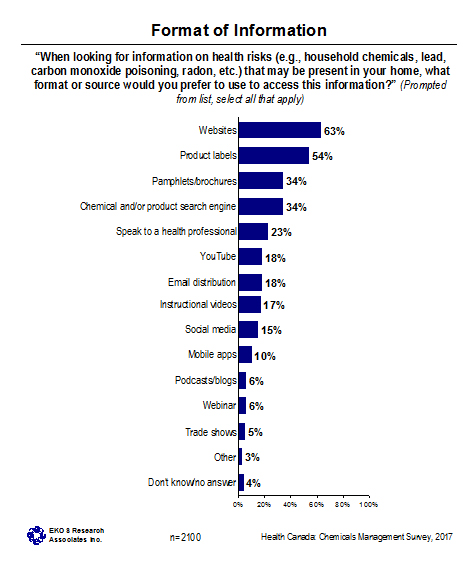
Focus group participants expressed interest in obtaining information in a variety of formats, including print (brochures, pamphlets), as well as online (websites, social media public service announcements/bulletins, You Tube videos) and through traditional media (shows and public service announcements on radio and television).
In terms of websites, easily accessible, well organized and easy to use information were described, as well as FAQs that allow readers to quickly scan for relevant information. Short, bulleted style also seems to work for many, along with infographics. This included detailed product information as well as specific steps to be taken (i.e., tips, and “how to” lists). Cost effective solutions to common problems and assistance for lower income households were also mentioned by a few. Use of plain and standardized language (i.e., avoiding technical terms or use of multiple terms for the same substance) were also seen as helpful. Easy, look up tables, where users can search for a product, were also suggested. Several also said that it is important to use plain and transparent language, and to avoid use of terms often used in marketing approaches, such as “natural” that consumers feel are open to interpretation.
In addition to a website with information, a call-in line that can be used to verify the safety of products was also seen as a format that would be valuable for some.
Also discussed was outreach in the community, including in-person contact (public meetings, information booths, seminars) particularly to prospective and new parents, and to parents through connections with schools and community activities. Some mentioned posters and pamphlets left in schools and community centres for parents to notice, read or take home, to pique interest, provide basic facts or checklists, along with a phone number and website for more information. Some participants in Toronto also spoke of educating children in schools to be aware and also to take the information home to inform parents. Some disagreed, however, citing the risk of raising anxiety with children about things that are outside of their control.
Participants were divided on the timing for this information. For some, having information in advance for general knowledge and awareness or in the planning stages of some renovation makes the most sense. For others, having access to a website (or app) in-store, when making actual purchasing decisions is the best time.
Respondents were presented with a list of six groups that routinely deliver information regarding household health risks and asked to rate the amount of trust they place in each one. Three-quarters of respondents expressed a high degree of trust in Health Canada (78 per cent) and health care professionals (76 per cent), while seven in ten (70 per cent) have faith in not-for-profit health groups, suggesting the latter two as potential trusted partners from the perspective of the public. Six in ten (56 per cent), meanwhile, would rate non-profit environmental groups as trustworthy. Respondents are considerably more cautious when it comes to manufacturers, retailers, and building contractors, with as many respondents rating these groups as less trustworthy. Compared with levels of confidence expressed in 2009, levels of trust seem higher in all areas in 2017. (Note that Health Canada was not asked in 2009.)
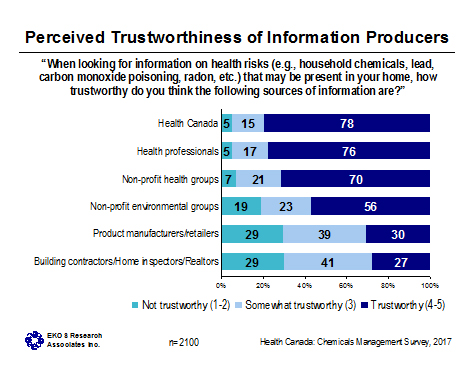
Results highlight a moderate level of interest in a mobile application that contains information about household chemicals and guidance on how to mitigate potential risks. Two-fifths of respondents (41 per cent) said they would be highly interested in such an app, although a similar proportion (35 per cent), expressed little to no interest. One in five (21 per cent) said they would be moderately interested.
Of those expressing at least some interest in the app, three in ten (29 per cent) said they would use it before shopping for a specific product, while one in five (22 per cent) would use it while shopping. Very few respondents (three per cent) indicated that they would use the app after the product had already been purchased. A plurality of respondents (43 per cent) selected some combination of these three options.
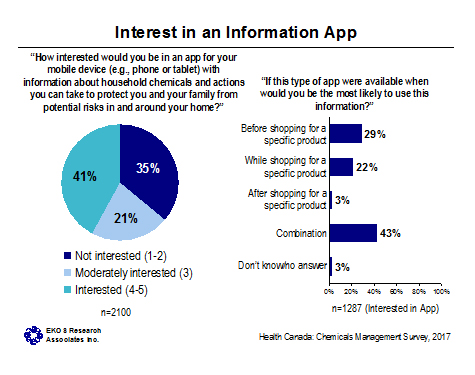
As with the survey results, interest expressed by focus group participants in a mobile app that provides product safety information was moderate at best. Although some said that they would use this from time to time to check on products, typically while shopping, most said that it would be of limited value and they would not use it often enough to warrant an app on their mobile device. Stipulations were that content would have to be very specific and yet easy to understand. They also said that content would need to be ever changing and updated to encompass new information and products as it is available, as well as to hold relevance and interest of users. Some expressed an interest in being able to scan a bar code at a store in order to see relevant information and safety concerns about the specific product.
In terms of structure, most said that the app would have to be very clearly organized and user-friendly; a complaint about many apps that are quickly deleted is that they are not sufficiently clear or easy to use. In Toronto, some participants stipulated that the app would have to be rolled out simultaneously on multiple platforms (iPhone, Android) to maximize benefit to all consumers. Some participants also complained that there is growing impatience with apps, particularly those not used daily, because they take up space, crowd mobile screen real estate and barrage users with unwanted notifications.
For a variety of reasons, many participants seemed to prefer websites that they can go to for information that they can access at any time, at home, or on the go, when they need it, which may not be often enough to warrant use of a mobile app, unless, perhaps they could use it to scan items to see relevant, product specific information (expressed as an interest by some).
The following summarizes key findings for the primary target group of parents of children six years of age or younger in contrast to other Canadians.
Focus group participants were presented with a list of six sample calls to action as examples of what a Health Canada social marketing campaign might target. Three general concepts were then presented and discussed as possible approaches for a campaign that might include some electronic/online advertising, some print and radio advertisement and some materials to assist in in-person promotional/outreach opportunities.
Overall, when presented with the sample calls to action, most participants agreed that these are reasonable requests and good things for Canadians to be mindful of. Some suggested that people already know about some of these things while others said that some are more difficult to do (e.g., test for radon). Nonetheless, most participants generally agreed that having this type of list of straightforward actions that could be taken to reduce the risks to health is useful for the public. A few suggested that it would be beneficial to couple this with the rationale (i.e., why is it important to do these things).
There was mixed reaction to the approach of linking the health of your home to your own health. Some saw this as a natural extension to caring for your health as the home environment has an influence on individual health. For those who commit to personal health through exercise and eating healthy, naturally, they would want to ensure they are not exposed to environmental factors or household products that negatively affect their health. For these participants, the personal maintenance and home maintenance are connected. However, a few said that the two are not related. This may have been, in part because participants in about half of the groups said that the idea of “home health” is confusing. “Is it about how your home makes you healthy or is about the actual health of your home (i.e., need for repairs or renovations).” “If my health is supposed to be based on how I treat my home, my health is in bad shape (because I don’t take very good care of my home)!” Many said that, whether or not they like the approach, the concept needs to be simplified and clarified so that it is more apparent that Canadians are being asked to think of the efforts they make to stay healthy, and extend these efforts to things they do in their home, as a natural part of the mix.
Many participants, through all three concepts, felt that an image of home was an appropriate and expected image with each message. However, generally participants did not like the icon presented in this concept. As noted by one, “that doesn’t look like my house” (the shape being narrow two story rather than bungalows found in Halifax). Participants envisioned further indicators of a home with the image, such as a chimney, walkway, or clothes line blowing in the breeze. While some associated the cross as representing health (such as Red Cross), others found that the cross within the house lead to the perception of church or hospital. There were a number of suggestions generally to use a heart to represent health rather than a cross.
This concept received the most positive reviews, with the exception of a few participants. Most liked the idea of a concrete set of actions that could be taken; a checklist for your home. This was imagined as leading to constructive information on how to and what to address in the home, which was seen as empowering in itself to have the information to be able to make changes. This is what seemed to be missing in the first and third concepts – the idea that there would be practical information on steps to take, what to change and/or how to change it.
Concerns were expressed, however, about the visualization of this as a “first aid kit” for two reasons. First, a first aid kit is something that already exists in many homes and it has a specific purpose. Repurposing this concept creates confusion. Second, use of a first aid kit is a reactive measure when something has gone wrong. It is expected that the ideas and information available would be much more proactive to ensure that there are no problems (i.e., preventative). Phrases such as tool kit or tool box and check lists were seen as better representations of the kind of resources that this would include. Again, some participants said that it would be important to add why it is important to do these things. Checklists in particular could be seen as empowering, giving one a sense of accomplishment when the issue was addressed (“check!”), that they have recommended steps for peace of mind. The idea of a check list, as indicated by a few, would encourage some to get around to actions they have been putting off due to inertia (such as installing a carbon monoxide detector, or properly disposing of old paint cans).
Again the icon was not seen as a good representation of this type of concept, largely because the cross and case seem like an actual first aid kit or doctor’s bag. Showing lists or information marked by a heart or other indicator of health (stethoscope, etc.) were seen as viable possibilities.
This is the concept that focus group participants liked the least, although one particular group in Calgary did find it appealing. Generally the concept of personal responsibility is seen as acceptable, but also obvious for some (“who else’s responsibility is it going to be?”). Empowerment is also seen as a tired and overused concept for many. Some participants also said that it adds undue pressure and guilt; that you must take responsibility, particularly when it is not coupled with the information and solutions you need to take action. A few felt that promoting empowerment to take actions on environmental factors and household products is a move by the government to deflect their responsibility. In the one group, in Calgary that liked this concept the best, they felt that it is important to emphasize to the public that it is up to them to do their research and make choices accordingly, and not to blame the world, saying “I didn’t know”, even though information is available for anyone who looks for it.
In particular, all participants, but one or two disliked the idea of the superhero imagery as part of the concept. They felt that the wave of superhero is entirely overdone and that it brings to the concept a lack of sincerity. By and large participants did not like the icon for this third concept (a shield) either, wondering how a shield relates to the idea of empowerment and taking responsibility. The shield brought to mind images of life insurance companies, and the Clash of the Clans video game.
While participants generally did not like the reactive message of a first aid kit, this concept was favoured in terms of the perception of providing “tools” or actions Canadians can take to ensure that preventative measures have been considered in their home (i.e., with this information/set of solutions, you will be able to make the changes you need to make). With this concept, more participants indicated they were likely to follow a link or website for more information. Some suggested that rather than the concept of responsibility or even coining the tired term of empowerment, there can be a celebration of success (You’ve made the changes. You did it!)
Some also liked the idea of the natural extension to changes in the home, but again, conveyed in a straightforward way. Several agreed that this concept could also be married under concept 2. The blended concept could convey the idea that you already take steps toward your health; here are some tips/ a checklist of things to look for in your home to increase protection for your whole family, giving you a sense of accomplishment and peace of mind.
Results suggest that most Canadians are generally aware of and acknowledge the potential health risks of household products and environmental factors. Focus group participants described this as an ever evolving awareness of the value of a healthy lifestyle, and the impacts of the choices we make on our health and the environment. Of particular concern in the survey are factors such as household chemicals, pesticides, air quality, mould, and water quality, which were echoed in focus group discussions. Perceived consequences of exposure to these factors are centred on breathing problems and cancer and for parents, impacts on the health and development of children.
Most Canadians also recognize that there are a wide range of steps that can be taken to mitigate the risks from these factors, with many indicating that how consumers use or dispose of common household products is a large part of the risk. Furthermore, most of those who participated in the survey have taken at least some steps to protect themselves from household contaminants. Focus group participants also described a wide range of efforts to reduce dangerous chemicals coming into the home, research consumer safety and methods of use and disposal of products, and pay attention to product labels. A note of caution should be interjected, however, in interpreting the results of both the online survey and the focus groups. The approach used in both lines of evidence created an environment where participants could select from lists of products of concern and/or steps they take (survey), or could build on the suggestions and descriptions made collectively in a group (focus groups). These likely resulted in some over reporting of the types of steps taken. Overwhelmingly, Canadians cite their health and the health of their family members as their motivation for taking these actions, although for many, this is also closely tied with impact on the environment.
Results point to an interesting dichotomy. On one hand, most Canadians seem fairly confident that they know what steps to take to prevent or reduce the health risks from environmental factors around the home. Those more economically vulnerable are perhaps a key exception, with many feeling less comfortable with their knowledge in this area.
On the other hand, although most Canadians recognize the risks of common environmental factors around their home and have taken actions to mitigate these hazards, fewer have looked for information on the steps to take to reduce risk. In particular, younger Canadians and those of lower socioeconomic status are the least likely to have searched for information. And, while most Canadians find the available information to be at least moderately helpful, many Canadians complain that this information is unreliable, not relevant, difficult to find, or overly technical and confusing. This was strongly articulated in the focus group discussions, with many saying that they simply do not trust many of the sources available, and that much of the information is designed to be confusing and misleading.
Also somewhat at odds with the confidence expressed by many, the study highlights a strong appetite for more information on how to mitigate the risks from common household products. The specific areas of interest largely reflect the areas with which they expressed concern (air quality, water quality, household chemicals, etc.). Both the survey evidence, and in particular, focus group discussions argue for a strong need for easy to access, relevant, and straightforward to understand and use information that Canadians can rely on, from trusted sources, to guide them in their choices.
Both the survey and focus groups favour Health Canada, health professionals, and non-profit health groups, seen as the most trusted messengers for this information. In particular, many focus group participants expressed frustration with the quality of information available, pointed to a strong role for government to provide information that Canadians can trust. Health professionals and non-profit health groups would be natural partners in these endeavours. Most Canadians currently rely on the Internet and product labels for their information; however, there appears to be little correlation between trust and use. For instance, more than half of Canadians make use of the manufacturers’ labels, yet product manufacturers rank next to last in terms of trust further arguing for government to fill the void in terms of information from a trusted source.
The study also looked at receptivity to a mobile application that contains information about household chemicals and guidance on how to mitigate potential risks. Most Canadians expressed at least some interest in the app, particularly parents with children six or younger and Quebec residents. At the same time, interest was not overwhelming and many expressed limited interest. Focus group participants described the value of having the information where you need it, when you need it, at a well publicized website, while, for many, mobile apps are viewed as best reserved for the functions that Canadians use daily.
Reactions from focus group participants to a number of possible concept approaches to a public education campaign echoed the kind of interest that Canadians expressed, in both the survey and discussions, for information that is easy to access, easy to understand and apply, and tells you what you need to know without technical jargon or other confusing details. It was for this reason that an approach that emphasizes helpful resources and reference lists was immediately found to be the most appealing to participants, rather than an approach that is focused on convincing Canadians of the importance of taking steps (‘Give us useful tools, that also serve as a good reminder, and we can take it from there’.)
Study results suggest that having children has a large impact on the level of attention Canadians pay to the impacts of household chemicals. Parents are consistently more likely to express concerns over the risks posed by household chemicals and environmental factors and are more likely to have sought information on how to mitigate these risks. At the same time, interest in information is acute in this segment, making them a natural primary target group for public education messages and information products. Key considerations for this segment are strong concerns for health risks to children, coupled with limited budgets and limited time and attention to find and digest information.
Similarly, age plays a significant role in taking action. Indeed, a number of focus group participants described getting older and feeling more vulnerable because of health concerns as the impetus to start thinking about these issues. Older Canadians (particularly those ages 55 and over) are more likely to have looked for information on how to assuage potential health risks and are more likely to have taken steps to do so. This segment is also a target group that is receptive to hearing about steps that can be taken to mitigate health risk, and are highly interested in information products that can help them make wise choices.
Lastly, women and residents of Quebec are consistently more likely to express concerns over the dangers posed by household chemicals and environmental factors. They are consistently more likely to have sought information on these risks and are more likely to have taken action to mitigate them. Interest levels are also stronger in these two segments, who will be highly receptive to resources and tools they can use to guide them.
We are conducting a survey and it will only take about 15 minutes.
Please rest assured that your answers are completely confidential (this means that no individual will be associated with the survey's results - rather, they will be rolled up into large categories to protect the confidentiality of each respondent) and that this survey is voluntary.
Instructions
* Please consider the questions and your answers carefully.
* On each screen, after selecting your answer, click on the "Continue" or "Back" buttons at the bottom of the screen to move forward or backwards in the questionnaire.
* If you leave the survey before completing it, you can return to the survey URL later, and you will be returned to the page where you left off. Your answers up to that point in the survey will be saved.
* If you have any questions about how to complete the survey, please call EKOS at 1-866-211-8881 or email us at online@ekos.com.
Q1
How much, if at all, do you believe you and/or your family's health is impacted by common environmental factors in and around your home (e.g., air/water quality, household chemicals)?
A great deal - 1
A fair amount - 2
Not very much - 3
Not at all - 4
Don't know / No answer - 9
PREQ2
What factors in and around your home do you think pose a risk to your health and the health your family
Select all that apply
Q2A [0,12]
Household products
Consumer product safety (e.g., children's toys, household furniture) - 1
Personal care products (e.g., cosmetics, shampoo) - 2
Air fresheners/room sprays/scented candles - 3
Household chemicals (e.g., kitchen and bathroom cleaners) - 4
Oil, turpentine, paint, paint strippers/thinners - 5
Lead contained in applied paint (e.g., on the surface of something within the home) - 6
Building materials/renovation projects (e.g., adhesives, sealants, insulation products) - 7
Materials used in hobbies/craft projects - 8
Pesticides, herbicides, insecticides - 9
Unused pharmaceuticals/drugs (human or veterinary) - 10
Improper disposal of pharmaceuticals drugs (human and veterinary) - 11
Natural health products - 12
Q2B [0,14]
Household Environmental Factors
Water Quality - 1
Air Quality - 2
Contaminated Soil - 3
Radiation (including electromagnetic radiation) - 4
Garbage/disposal of products - 5
Radon gas - 6
Wireless devices - 13
Mould/humidity - 7
Carbon monoxide - 8
Food safety (e.g., safe handling practices and preparation) - 9
Cigarette smoke - 10
Noise (e.g., loud toys, earbuds) - 11
Wood smoke - 12
Individual chemicals (please specify) - 78
Q2C [0,2]
Other (please specify) - 77 B Don't know / No answer - 99 BX
Q3 [1,3]
If... Q2C not = 99
Which of the following are you the most concerned about for you and your family?
Select up to 3
Q2A = 1
Consumer product safety (e.g., children's toys, household furniture) - 1
Q2A = 2
Personal care products (e.g., cosmetics, shampoo) - 2
Q2A = 3
Air fresheners/room sprays/scented candles - 3
Q2A = 4
Household chemicals (e.g., kitchen and bathroom cleaners) - 4
Q2A = 5
Oil, turpentine, paint, paint strippers/thinners - 5
Q2A = 6
Lead contained in applied paint (e.g., on the surface of something within the home) - 6
Q2A = 7
Building materials/renovation projects (e.g., adhesives, sealants, insulation products) - 7
Q2A = 8
Materials used in hobbies/craft projects - 8
Q2A = 9
Pesticides, herbicides, insecticides - 9
Q2A = 10
Unused pharmaceuticals/drugs (human or veterinary) - 10
Q2A = 11
Improper disposal of pharmaceuticals drugs (human and veterinary) - 11
Q2A = 12
Natural health products - 12
Q2B = 1
Water Quality - 14
Q2B = 2
Air Quality - 15
Q2B = 3
Contaminated Soil - 16
Q2B = 4
Radiation (including electromagnetic radiation) - 17
Q2B = 5
Garbage/disposal of products - 18
Q2B = 6
Radon gas - 19
Q2B = 13
Wireless devices - 28
Q2B = 7
Mould/humidity - 20
Q2B = 8
Carbon monoxide - 21
Q2B = 9
Food safety (e.g., safe handling practices and preparation) - 22
Q2B = 10
Cigarette smoke - 23
Q2B = 11
Noise (e.g., loud toys, earbuds) - 24
Q2B = 12
Wood smoke - 25
Q2B = 78
Individual chemicals: __________ - 26
Q2C = 77
Other: __________ 27
Don't know / No answer - 99 X
Q4 [1,15]
What types of chemicals, or products with chemicals, do you believe pose a risk to the health of you and your family?
Select all that apply
Lead 1
Bisphenol A/BPA 2
Dioxin/PCB's 3
Flame retardants 4
Phthalates 5
Dyes and Pigments 6
Asbestos 7
Boron/Boric Acid 8
Microbeads 9
Triclosan/anti-microbials 10
Mercury 11
Arsenic 12
Ethylbenzene 13
Formaldehyde 14
Nanomaterials 15
Nothing specific 98 X
Don't know / No answer 99 X
Q5 [1,10]
What types of potential health problems from exposure to chemical substances in your home are you currently concerned about?
Select all that apply
Poisoning 1
Cancer 2
Breathing problems (e.g., respiratory disease/asthma) 3
Neurological problems (e.g., brain disease) 4
Digestive problems/stomach disease 5
Impact on children's health and/or development 6
Reproductive/fertility effects 7
Chemical sensitivities (e.g., perfumes, soaps) 8
Allergies 9
Other (please specify) 77
None 98 X
Don't know / No answer 99 X
PREQ6
To what extent do you agree or disagree with the following?
Q6A
How consumers use or misuse common household products is a large part of the risk posed to health
Completely disagree 1 - 1
2 - 2
Neither 3 - 3
4 - 4
Completely agree 5 5
Q6B
How consumers dispose of common household products is a large part of the risk posed to health
Completely disagree 1 - 1
2 - 2
Neither 3 - 53
4 - 4
Completely agree 5 - 5
Don't know/ No answer 9
Q6C
Chemicals in common household products pose a significant health risk no matter how they are used or disposed of by consumers
Completely disagree 1 - 1
2 - 2
Neither 3 - 3
4 - 4
Completely agree 5 - 5
Don't know/ No answer - 9
Q6D
It's possible to take steps to prevent or lower the health risk posed by common household
Completely disagree 1 - 1
2 - 2
Neither 3 - 3
4 - 4
Completely agree 5 - 5
Don't know/ No answer - 9
Q6F
It is possible to test for some chemicals in your home that pose a health risk
Completely disagree 1 - 1
2 - 2
Neither 3 - 3
4 - 4
Completely agree 5 - 5
Don't know/ No answer - 9
Q7
Many of us know something is a health risk, but we don't always do anything about it. If you had information about possible health risks in and around your home, and steps you could take, how likely would you be to make changes to reduce the risk?
Not at all likely 1 - 1
2 - 2
Moderately likely 3 - 3
4 - 4
Extremely likely 5 - 5
Don't know / No answer - 9
Q7B
If... Q7 = 1,2,3
Could you expand on why it is you feel this way?
Don't understand the information/too complicated - 1
Contradictory information/confusing - 2
Don't trust the information - 3
Not enough time - 4
Too expensive/not enough money - 5
I rent my house/apartment so I don't have control to make certain changes - 6
It doesn't seem that important - 7
Don't understand the language well enough to know what to do - 8
Don't think it will make that much of a difference - 9
I never get around to it - 10
Don't think it's that big of a problem - 11
Other (please specify) - 77
Don't know / No answer - 99
Q8
How confident are you that you know what steps to take to prevent or reduce the health risk to you and your family from environmental factors in and around your home?
Not at all confident 1 - 1
2 - 2
Moderately confident 3 - 3
4 - 4
Extremely confident 5 - 5
Don't know / No answer - 9
Q9
Have you ever looked for information on what steps you can take to prevent or reduce risk from environmental contaminants in and around your home?
Yes - 1
No - 2
Don't know / No answer - 9
Q10
If... Q9 = 1
Generally, how helpful have you found the information to be in determining what to look for in possible health risks or steps you can take to reduce the risk to you and your family?
Not very helpful 1 - 1
2 - 2
Moderately helpful 3 - 3
4 - 4
Very helpful 5 - 5
Don't know / No answer - 9
Q10B [1,9]
If... Q9 = 1 and Q10 = 1,2,3
What aspects about the information were not helpful?
Select all that apply
Not enough information - 1
Confusing/too technical - 2
Not what I wanted to know - 3
Lack of confidence in the source of information - 4
Hard to find - 5
Too much information/overwhelming - 6
Not practical - 7
Didn't cover the impacts or consequences of exposure - 8
Other (please specify) - 77
Don't know / No answer - 99 X
Q10C
If... Q9 = 1 and Q10 = 4,5
What aspects about the information were helpful?
Please specify - 77
Don't know / No answer - 99
Q11 [1,17]
Have you personally taken any of the following steps in the past year to protect your health and the health of your family from environmental contaminants or factors in and around your home?
Select all that apply
Maintain a smoke free home - 1
Read all instructions and warning labels on products you buy - 2
Open windows and ensure proper ventilation - 3
Use protective equipment, such as gloves, when using chemical products - 4
Properly dispose of unused or expired pharmaceuticals/drugs - 5
Use products with fewer chemicals - 6
Increase frequency of cleaning/vacuuming/minimize dust - 7
Reduce time spent in problem location/area - 8
Talk to family/friends/neighbours - 9
Get information/do research (online or other sources) - 10
Follow all instructions and warning labels on products you buy - 11
Talk to a health professional - 12
Test for radon in your home - 13
Remove source of problem (e.g. carpeting, mould, chemical products) - 14
Hire a professional to help with renovation issues (e.g., removal of asbestos, lead paint) - 15
Take action to reduce radon levels if the level is high - 16
Other (please specify) - 77
No steps taken - 98 X
Don't know / No answer - 99 X
Q11B
If... Q11 not = 99
What prompted you to take these steps?
Please specify - 77
Don't know / No answer - 99
Q12
If... Q11 not = 99 and Q9 = 1
Did you take these steps as a result of the information you heard or read?
Yes - 1
No - 2
Partially - 3
Don't know / No answer - 9
Q13 [1,17]
If... Q11 = 98,99
What steps are you most likely to take to prevent or lower the health risk to you and your family from environmental factors in and around the home?
Select all that apply
Maintain a smoke free home - 1
Read all instructions and warning labels on products you buy - 2
Open windows and ensure proper ventilation - 3
Use protective equipment, such as gloves, when using chemical products - 4
Properly dispose of unused or expired pharmaceuticals/drugs - 5
Use products with fewer chemicals - 6
Increase frequency of cleaning/vacuuming/minimize dust - 7
Reduce time spent in problem location/area - 8
Talk to family/friends/neighbours - 9
Get information/do research (online or other sources) - 10
Follow all instructions and warning labels on products you buy - 11
Talk to a health professional - 12
Test for radon in your home - 13
Remove source of problem (e.g. carpeting, mould, chemical products) - 14
Hire a professional to help with renovation issues (e.g., removal of asbestos, lead paint) - 15
Take action to reduce radon levels if the level is high - 16
Other (please specify) - 77
No steps taken - 98 X
Don't know / No answer - 99 X
PREQ14
Sometimes there are things that keep us from getting the information we need or taking steps to prevent or reduce health risks from environmental factors in the home. To what extent have each of the following kept you and your family from taking action?
Q14A
Information hard to find
Not at all 1 - 1
2 - 2
To a moderate extent 3 - 3
4 - 4
Completely 5 - 5
Not applicable (have not looked/ tried to make changes) - 8
Don't know/ No answer - 9
Q14B
Information is confusing/too technical/too complicated/too many competing messages
Not at all 1 - 1
2 - 2
To a moderate extent 3 - 3
4 - 4
Completely 5 - 5
Not applicable (have not looked/ tried to make changes) - 8
Don't know/ No answer - 9
Q14C
Information is not available when making decisions (e.g., at time of purchase)
Not at all 1 - 1
2 - 2
To a moderate extent 3 - 3
4 - 4
Completely 5 - 5
Not applicable (have not looked/ tried to make changes) - 8
Don't know/ No answer - 9
Q14D
Lack of control to make certain changes
Not at all 1 - 1
2 - 2
To a moderate extent 3 - 3
4 - 4
Completely 5 - 5
Not applicable (have not looked/ tried to make changes) - 8
Don't know/ No answer - 9
Q14E
Too time consuming to make changes
Not at all 1 - 1
2 - 2
To a moderate extent 3 - 3
4 - 4
Completely 5 - 5
Not applicable (have not looked/ tried to make changes) - 8
Don't know/ No answer - 9
Q14F
Too expensive to take steps/make changes
Not at all 1 - 1
2 - 2
To a moderate extent 3 - 3
4 - 4
Completely 5 - 5
Not applicable (have not looked/ tried to make changes) - 8
Don't know/ No answer - 9
Q15
If... Number of responses in Q14 with 4,5 chosen > 1
Which of these do you find to be the largest single barrier to taking action to reduce the health risk of products in and around your home?
Q14A = 4,5
Information hard to find - 1
Q14B = 4,5
Information is confusing/too technical/too complicated/too many competing messages - 2
Q14C = 4,5
Information is not available when making decisions (e.g., at time of purchase) - 3
Q14D = 4,5
Lack of control to make certain changes - 4
Q14E = 4,5
Too time consuming to make changes - 5
Q14F = 4,5
Too expensive to take steps/make changes - 6
Don't know / No answer - 9
PREQ16 How much of a reason are each of the following for you to take steps to prevent or reduce health risks from environmental factors in the home?
Q16A
My health/the health of my family
Not at all 1 - 1
2 - 2
To a moderate extent 3 - 3
4 - 4
Completely 5 - 5
Don't know/ No answer - 9
Q16B
It increases the value of my home
Not at all 1 - 1
2 - 2
To a moderate extent 3 - 3
4 - 4
Completely 5 - 5
Don't know/ No answer 9
Q16D
Someone else I know is doing it
Not at all 1 - 1
2 - 2
To a moderate extent 3 - 3
4 - 4
Completely 5 - 5
Don't know/ No answer - 9
Q16E
It's good for the environment
Not at all 1 - 1
2 - 2
To a moderate extent 3 - 3
4 - 4
Completely 5 - 5
Don't know/ No answer - 9
Q16F
Someone prompts me to take action
Not at all 1 - 1
2 - 2
To a moderate extent 3 - 3
4 - 4
Completely 5 - 5
Don't know/ No answer - 9
Q17
Need for Information
Some people look for information while others do not. When you purchase a product, how often do you look for information about what these products contain before purchasing?
Always - 1
Most of the time - 2
Sometimes - 3
Almost never - 4
Don't know / No answer - 9
Q18
How interested would you be in learning more about how to protect your health and the health of your family in and around the home?
Not very interested 1 - 1
2 - 2
Moderately interested 3 - 3
4 - 4
Very interested 5 - 5
Don't know / No answer - 9
PREQ19
If... Q18 = 3,4,5
What types of environmental health factors in and around your home are you most interested in learning more about?
Select all that apply
Q19A [0,12]
If... Q18 = 3,4,5
Household products
Consumer product safety (e.g., children's toys, household furniture) - 1
Personal care products (e.g., cosmetics, shampoo) - 2
Air fresheners/room sprays/scented candles - 3
Household chemicals (e.g., kitchen and bathroom cleaners) - 4
Oil, turpentine, paint, paint strippers/thinners - 5
Lead contained in applied paint (e.g., on the surface of something within the home) - 6
Building materials/renovation projects (e.g., adhesives, sealants, insulation products) - 7
Materials used in hobbies/craft projects - 8
Pesticides, herbicides, insecticides - 9
Unused pharmaceuticals/drugs (human or veterinary) - 10
Improper disposal of pharmaceuticals drugs (human and veterinary) - 11
Natural health products 12
Q19B [0,16]
If... Q18 = 3,4,5
Environmental Factors
Water Quality - 1
Air Quality - 2
Contaminated Soil - 3
Radiation (including electromagnetic radiation) - 4
Garbage/disposal of products - 5
Radon gas - 6
Wireless devices - 13
Mould/humidity - 7
Carbon monoxide - 8
Food safety (e.g., safe handling practices and preparation) - 9
Cigarette smoke 10
Noise (e.g., loud toys, earbuds) - 11
Wood smoke - 12
Individual chemicals (please specify) - 78
Q19C [0,2]
If... Q18 = 3,4,5
Other (please specify) - 77 B
Don't know / No answer - 99 BX
PREQ20
When looking for information on health risks (e.g., household chemicals, lead, carbon monoxide poisoning, radon, etc.) that may be present in your home, which sources would you prefer to access this information from?
Select all that apply
Q20A [0,11]
Internet
Search Engine (e.g., Google, Yahoo, etc) - 1 B
Health Canada website (e.g., healthycanadians) - 2 B
Other Government of Canada website - 3 B
Provincial government website - 4
Municipal government website - 5
Website outside of Canada - 6
Environmental group website - 7
Consumer group website - 8
Health professional website - 9
Manufacturers - 10
Q20B [0,10]
Non-internet sources
Friends - 1
Home shows or consumer shows - 2
Health professionals - 3
Building contractors/Home inspectors/Realtors - 4
Manufacturers product label - 5
1-800-O-Canada - 6
Magazines, newspapers or books - 7
News media - 8
Retailers/At point of purchase - 9
Q20C [0,2]
Other (please specify) - 77 B
Don't know / No answer - 99 BX
Q21 [1,16]
When looking for information on health risks (e.g., household chemicals, lead, carbon monoxide poisoning, radon, etc.) that may be present in your home, what format or source would you prefer to use to access this information?
Select all that apply
Websites - 1
Pamphlets/brochures - 2
Instructional videos - 3
Podcasts/blogs - 4
Mobile apps - 5
Social media (e.g., Facebook, Twitter, Pinterest) - 6
YouTube - 9
Trade shows - 10
Speak to a health professional - 11
Webinar - 12
Chemical and/or product search engine - 13
Email distribution list of latest information - 14
Product labels - 15
Other (please specify) - 77 B
Don't know / No answer - 99 XB
PREQ22
Information Sources
When looking for information on health risks (e.g., household chemicals, lead, carbon monoxide poisoning, radon, etc.) that may be present in your home, how trustworthy do you think the following sources of information are?
Q22A
Product manufacturers/retailers
Not trustworthy at all 1 - 1
2 - 2
Somewhat trustworthy 3 - 3
4 - 4
Very trustworthy 5 - 5
Don't know/ No answer - 9
Q22B
Health Canada
Not trustworthy at all 1 - 1
2 - 2
Somewhat trustworthy 3 - 3
4 - 4
Very trustworthy 5 - 5
Don't know/ No answer - 9
Q22C
Non-profit health groups, such as the Canadian Cancer Society
Not trustworthy at all 1 - 1
2 - 2
Somewhat trustworthy 3 - 3
4 - 4
Very trustworthy 5 - 5
Don't know/ No answer - 9
Q22D
Health professionals such as doctors and public health nurses
Not trustworthy at all 1 - 1
2 - 2
Somewhat trustworthy 3 - 3
4 - 4
Very trustworthy 5 - 5
Don't know/ No answer - 9
Q22E
Non-profit environmental groups (e.g.. Pollution Probe, David Suzuki Foundation)
Not trustworthy at all 1 - 1
2 - 2
Somewhat trustworthy 3 - 3
4 - 4
Very trustworthy 5 - 5
Don't know/ No answer - 9
Q22F
Building contractors/Home inspectors/Realtors
Not trustworthy at all 1 - 1
2 - 2
Somewhat trustworthy 3 - 3
4 - 4
Very trustworthy 5 - 5
Don't know/ No answer - 9
Q23
How interested would you be in an app for your mobile device (e.g., phone or tablet) with information about household chemicals and actions you can take to protect you and your family from potential risks in and around your home?
Not at all interested 1 - 1
2 - 2
Moderately interested 3 - 3
4 - 4
Extremely interested 5 - 5
Don't know / No answer - 9
Q23B
If... Q23 = 3,4,5
If this type of app were available when would you be the most likely to use this information?
Before shopping for a specific product - 1
While shopping for a specific product - 2
After shopping for a specific product - 3
Combination - 4
Don't know / No answer - 9
QDEMO
These last questions are for statistical purposes and we remind you that all your answers are completely confidential.
QBORN
In what year were you born?
Year - 1 <
Don't know / No answer - 9999
QEDUC
What is the highest level of formal education that you have completed to date?
Grade 8 or less - 1 Some high school - 2 High school diploma or equivalent - 3 Registered Apprenticeship or other trades certificate or diploma - 4 College, CEGEP or other non-university certificate or diploma - 5 University certificate or diploma below bachelors level - 6 Bachelor's degree - 7 Post graduate degree above bachelor's level - 8 Don't know / No answer - 9
QINCOME
Which of the following categories best describes your total household income? That is, the total income of all persons in your household, before taxes?
Under $20,000 - 1
$20,000 to just under $40,000 - 2
$40,000 to just under $60,000 - 3
$60,000 to just under $80,000 - 4
$80,000 to just under $100,000 - 5
$100,000 to just under $120,000 - 6
$120,000 to just under $150,000 - 7
$150,000 and above - 8
Don't know / No answer - 9
QHOME
Which one of the following categories describes your home?
A single-family house detached from any other house - 1
A single-family house attached to one or more houses, for example a townhouse or duplex - 2
An apartment building or condominium no more than four stories - 3
An apartment building or condominium five or more stories - 4
A mobile home or trailer - 5
Other (please specify) - 77
Don't know / No answer - 99
QOWNRENT
Do you own or rent your home?
Own it - 1
Rent it - 2
Don't know / No answer - 9
QBORNCAN
Were you born in Canada?
Yes - 1
No - 2
Don't know / No answer - 9
QLANG [1,3]
What is the language you speak most often at home?
Select all that apply
English - 1
French - 2
Other (please specify) - 77
Don't know / No answer - 99 X
QCHILD
Are you the parent or legal guardian of any children currently living in the household? If so, how many?
Yes (please enter number of children) : 77 >
No - 98
Don't know / No answer - 99
QCHILDB [1,5]
Parents, QCHILD
What are the ages of children in the home?
Select all that apply
6 and under 1
7 to 12 - 2
13 to 15 - 3
16 to 18 - 4
19 or older - 5
Don't know / No answer - 9 X
QSENIOR
Are there individuals living in your home who are 65 years of age or older?
Yes - 1
No - 2
Don't know / No answer - 9
QHRISK
If... QCHILDB not = 1 and QSENIOR not = 1
Are there individuals living in your home who are vulnerable to health risks?(e.g., children and pregnant women, Indigenous peoples, seniors)?
Yes - 1
No - 2
Don't know / No answer - 9
QPOSTC
What are the first 3 digits of your postal code?
Please specify : 1
Don't know / No answer - 9
QGENDR
Are you...?
Male - 1
Female - 2
Other - 3
Don't know / No answer - 9
THNK
This completes the survey. On behalf of Health Canada, thank you very much for your participation.
Please note that information included in these questions should not be considered as advice, nor should you act on any of the information in this survey. Should you be interested in learning more about environmental health issues in and around your home, please refer to Health Canada's information on Hazards in your Home
INTRO
<RINTRO: [PRESTRATE = 1]Time and Date: Wednesday, February 22th from 5:30 p.m. to 7:30 p.m.Hello, my name is ________________ from EKOS Research. We are conducting a series of focus group discussions with Canadians who are 18 years of age or older on behalf of the Government of Canada. The research is related to health issues of concern to all Canadians and we think that you’ll find the topic interesting.
Your participation in the research is completely voluntary and your decision to participate or not will not affect any dealings that you may have with EKOS Research or the Government of Canada. The purpose of the research is to understand the opinions and experiences of Canadians not to sell any service or product.
The sessions will be audio and video recorded for research purposes. Representatives of the Government of Canada will also be observing the discussions. The information is being collected under the authority of the Privacy Act and other applicable privacy laws. The full names of participants will not be provided to the government or any other third party. Also, the results from the discussions will be grouped together in a report, which will contain non-identifying information. May I continue?
Yes - 1
No - 2 ->THNK2
Q1
The session will last between an hour and a half and two hours and an incentive is offered for participation. May we have your permission to ask you some further questions to see if you fit in our study?
Yes - 1
No - 2 ->THNK2
QGENDR
<ISEX: [{ $contexte{ip} =~ /192.168.0.?/ }]Record gender of respondent (DO NOT ASK)[ELSE]Are you...>
Male - 1
Female - 2
QAGEX
May I have your year of birth, please?
RECORD YEAR : 77 >
REFUSED - 99
QAGEY
Hesitant
If... QAGEX = 99
Would you be willing to tell me in which of the following age categories you belong?
Under 18 years - 1 ->THNK2
18 – 34 years - 2
35 – 55 years - 3
55+ years - 4
QEDUC
What is the highest level of formal education that you have completed to date?
Grade 8 or less - 1
Some high school - 2
High school diploma or equivalent - 3
Registered Apprenticeship or other trades certificate or diploma - 4
College, CEGEP or other non-university certificate or diploma - 5
University certificate or diploma below bachelors level - 6
Bachelor's degree - 7
Post graduate degree above bachelor's level - 8
Don't know / No answer - 9
QINCOME
Which of the following categories best describes your total household income? That is, the total income of all persons in your household, before taxes?
Under $20,000 - 1
$20,000 to just under $40,000 - 2
$40,000 to just under $60,000 - 3
$60,000 to just under $80,000 - 4
$80,000 to just under $100,000 - 5
$100,000 to just under $120,000 - 6
$120,000 to just under $150,000 - 7
$150,000 and above - 8
Don't know / No answer - 9
QCHILD
Are you the parent or legal guardian of any children currently living in the household? If so, how many?
Yes (please enter number of children) : 77 >
No - 98
Don't know / No answer - 99
QCHILDB [1,5]
Parents, QCHILD
If... QCHILD = 77
What are the ages of children in the home?
Select all that apply
6 and under - 1
7 to 12 - 2
13 to 15 - 3
16 to 18 -
19 or older - 5
Don't know / No answer - 9 X
Parents of kids six or younger
Others
Q2
Are you or is any member of your household or immediate family employed in:
Q2A
Government of Canada
Yes - 1
No - 2
Q2B
An advertising agency
Yes - 1
No - 2
Q2C
A market research company
Yes - 1
No - 2
Q2D
The media (Print, Radio, TV, Internet)
Yes - 1
No - 2
Q2e
Working in the field of health care
Yes - 1
No - 2
Q3
Participants in group discussions are asked to voice their opinions and thoughts. How comfortable are you in voicing your opinions in front of others, in English? Are you...
Very Comfortable - 1
Comfortable - 2
Fairly Comfortable - 3
Not Very Comfortable - 4 ->THNK2
Very Uncomfortable - 5 ->THNK2
Q4
Have you ever attended a focus group or one to one discussion for which you have received a sum of money?
Yes - 1
No - 2
Q5
If... Q4 = 1
When did you last attend one of these discussions that was sponsored by the Government of Canada?
Please specify : 77 >N
Months - 1
Years - 2
Never - 999
Within last 6 months, thank and terminate - 1 ->THNK2
Continue 99
Q5B
If... Q4 = 1 and Q5 not = 999
Have you attended more than 6 of these discussions that were sponsored by the Government of Canada?
Yes - 1 ->THNK2
No - 2
QFOCUS
The focus group is an hour and a half in length, but we are asking that all participants arrive 10 minutes prior to the start time of the session. Are you able to be at the facility 10 minutes prior to the session time?
Yes - 1
No - 2 ->THNK2
QTELE
We are providing each participant with a $75 cash incentive for their participation, although late arrival (i.e., more than a few minutes) may result in not being able to participate or receive the incentive. Replacements are not permitted and you will need to bring ID, which you may be asked to present on arrival for the discussion. The group will be taking place :
<RRECRUIT: [PRESTRATE = 1] Wednesday, February 22nd from 5:30 p.m. to 7:30 p.m.
Location: CRC Research House, 1867 Yonge Street, Suite 200, Toronto, Ontario M4S 1Y5[ELSE] Wednesday, February 22nd from 7:30 p.m. to 9:30 p.m.
Location: CRC Research House, 1867 Yonge Street, Suite 200, Toronto, Ontario M4S 1Y5>
We will be giving you a reminder telephone call a day or two prior to your group discussion. Is this the best number at which to reach you?
Yes - 1
No, please provide alternate phone number : 2
FNAME
Please provide your first and last names.
NOTE TO INTERVIEWER: Confirm proper spelling. Ensure proper capitalization (IE: not all upper or lowercase).
Name : 1
THNK
If you have any questions or something comes up and you can no longer participate in the discussions, please let us know by calling us toll-free at 1-800-388-2873 or by sending an e-mail to rzito@ekos.com. Thank you for your cooperation and time.
End of Interview
Completion - 1 D
THNK2
If... QEND is empty
I am very sorry, but due to the parameters of the study we will not be able to include you in the focus groups.
QFIL2
If... QEND is empty and QFIL = 1,2
Thank you for your cooperation! <QFIL2: [QFIL = 1 and QEND is empty]We will contact you should space become available in the group.[ELSE]>
HEALTHY HOME
FOCUS GROUP MODERATORS GUIDE
FEBRUARY 2017
1. Let’s start by going around the table. Tell me your first name, and who you have in your household?
2. Do you feel there are any environmental factors or household products in and around your home that you are concerned about in terms of health risk to you or your family? What are they?
3. Which factors concern you the most in terms of risks to health? Why do these concern you more than others?
4. Do you feel you are well enough informed of risks associated with environmental factors or household products?
5. Do you feel it’s possible to take steps to prevent or lower the health risk of these factors? Do some environmental factors or household products pose a risk no matter what you do?
a. Is your level of concern tied up in any way with your ability to control the risk factor?6. Do you currently take any action to prevent these risks?
7. How have you decided what steps you will take and what you won’t. Are there some steps that are too much trouble or not reasonable to do?
8. Are there any factors that are important reasons to you personally for taking steps to prevent or reduce health risks from environmental factors in the home?
9. Does cost ever get in the way of taking action? Are there some actions that are just too expensive to do (like a renovation to remove lead paint or asbestos) or that just add up over time (buying eco products)?
10. Are there things that you just aren’t able to do but would like to, because you rent your home or live in a condo, for example, or just can’t get anyone to help you with?
11. For those of you not taking any steps or for those of you who think you could do more, what are the things that hold you back from taking steps or making changes to prevent risk?
12. What got you started thinking about or taking steps to mitigate risk? Did you go looking for information or did you happen upon it or learn from friends and family?
13. Some of you have already started making changes or continue to make decisions around environmental factors and household products. What additional types of things would be helpful to know in terms of taking more steps to reduce risk?
14. Where would you look for this information? What kind of format should they be in? What types of things should this information emphasize?
15. How useful have you found the information available to you?
16. How trustworthy do you feel that the information you typically find is? What sources or types of information do you tend to trust the most? Why or why not?
17. Is there a format that works best for you when you are trying to use this type of information? (Product label, video, brochure?) Why?
18. When do you want to have that information in the store? When you are planning?
19. In the survey we found that about 4 in 10 thought that a mobile app with this type of product information could be useful, but interest was not huge? Why do you think that is? Would it be something you would use? Why or why not?
Now we are going to look at some concepts from the Government of Canada and get everyone’s reaction to them. Your feedback is important and will feed into developing some new materials to help Canadians take action to protect themselves from environmental factors in and around their home.
20. Remember that there are no right or wrong answers here. Everybody has an equally valid opinion.
21. Of the material, looking at them now side by side, which one do you think is the best overall concept? Which one does the best job of getting your attention? Of conveying a clear message to find out more or think about the program? Why?
22. Is there anything that we haven’t talked about or that you would like to add?
23. Is there anything that we haven’t talked about that you want to talk about before we go?
THANK YOU
Your Feedback is Important
The Government of Canada is developing some new materials to help Canadians take action to protect themselves from environmental factors in and around their home.
Sample Calls to Action Throughout the Three Concepts
Care for your home health as you would for your own health.
Descriptor
Images
Healthy home first aid kit
Descriptor
Images
You are empowered
Descriptor
Images